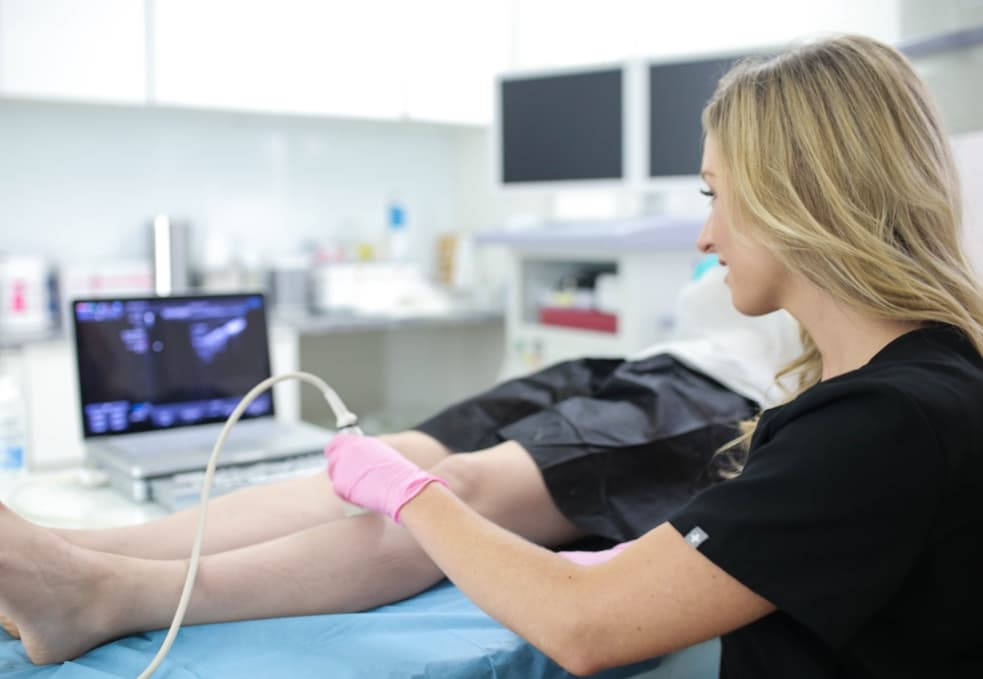Varicose veins can be a painful and unsightly condition that affects many individuals, often causing discomfort and insecurity. At Long Island Vein Center, led by board-certified vein doctors, we understand the importance of both effective treatment and prevention. In this guide, we discuss how to prevent varicose veins from coming back or reduce the risk of recurrence, covering risk factors, lifestyle changes, and treatment options.

Why There Are No Guaranteed Ways to Prevent Varicose Veins
While there are certainly effective measures you can take to reduce the risk of developing varicose veins, it’s essential to acknowledge that there are no foolproof methods to guarantee their prevention. Varicose veins can result from a complex interplay of genetic, hormonal, and lifestyle factors, making it challenging to completely eliminate the risk.
Even with a healthy lifestyle and diligent preventive measures, individuals with a strong family history of varicose veins may still be predisposed to this condition. Hormonal fluctuations, such as those occurring during pregnancy or menopause, can also influence vein health. While we can strive for a healthy lifestyle, it’s crucial to understand that varicose veins may not be entirely avoidable, but they can certainly be managed and treated effectively with the right medical interventions and lifestyle adjustments.
The Risk Factors for Varicose Veins:
- Family History: Genetics plays a substantial role in the development of varicose veins. When close family members, such as parents or siblings, have a history of varicose veins, your risk increases significantly. This genetic predisposition can involve factors like the inherent weakness of vein walls and valves, which can be passed down through generations.
- Gender: Varicose veins affect women more frequently than men — about 55% of women will experience them at some point in their lives. This gender disparity primarily stems from hormonal fluctuations that women undergo during various life stages. Hormones like estrogen and progesterone can affect vein elasticity, increasing the risk of varicose veins.
- Age: As we age, the veins in our legs naturally lose some of their elasticity and efficiency. Veins contain tiny valves that help prevent blood from flowing backward. Over time, these valves can weaken, leading to blood pooling and vein enlargement. Aging-related changes in veins make it more challenging for them to effectively transport blood back to the heart, which increases the likelihood of varicose veins, especially among older individuals.
- Prolonged Sitting or Standing: Occupations or lifestyles that require long periods of sitting or standing can contribute to the development of varicose veins. When you remain in one position for extended periods, it can impede blood flow in the legs. This stagnant blood can cause veins to work harder to push blood against gravity, potentially leading to vein damage. People in jobs like office work, drivers, or nurses are at greater risk.
- Obesity: Excess body weight places added pressure on the veins in your legs. This increased pressure makes it more challenging for veins to efficiently transport blood back to the heart, ultimately raising the risk of varicose veins. Maintaining a healthy weight through proper diet and regular exercise is crucial for reducing this risk.
- Pregnancy: During pregnancy, the growing uterus exerts significant pressure on the pelvic veins and the large vein on the right side of your body known as the inferior vena cava. This pressure can slow down blood flow from your lower body to your heart, leading to increased pressure in the leg veins. As a result, pregnancy often leads to the development of varicose veins in the legs. Fortunately, these veins often improve after childbirth.
- Inactive Lifestyle: A sedentary lifestyle can weaken overall vein health. Physical inactivity can lead to poor blood circulation, making it more challenging for veins to push blood against gravity, especially in the legs. Engaging in regular physical activity, such as walking, swimming, or cycling, helps improve blood flow and reduces the risk of varicose veins.
- Previous Venous Conditions: If you’ve had previous venous conditions, such as blood clotting or deep vein thrombosis (DVT), your vein health may be compromised. Such conditions can cause structural damage to veins, making them more susceptible to developing varicose veins. It’s essential to inform your vein doctor of any past venous issues to receive appropriate monitoring and preventive guidance.
- Tight Clothing: Wearing tight clothing, particularly garments that constrict the waist or groin area, can restrict blood flow. This constriction can make it harder for veins to function correctly, potentially increasing the risk of varicose veins. Choosing loose-fitting clothing and avoiding garments that tightly compress the waist or legs can help improve blood circulation.
How to Reduce the Risk of Varicose Veins:
- Regular Exercise: Engaging in regular physical activity is essential for promoting healthy blood circulation and maintaining strong muscles that support your veins. Exercises such as walking, swimming, and cycling are excellent choices because they work the calf muscles, which play a crucial role in pumping blood from your legs back to your heart. Regular exercise also helps prevent blood from pooling in your veins, reducing the risk of varicose veins.
- Maintain a Healthy Weight: Maintaining a healthy weight is crucial for reducing the pressure on your leg veins. When you carry excess weight, it places added strain on your veins, making it harder for them to function optimally. Losing excess pounds through a balanced diet and regular exercise lowers the risk of varicose veins and alleviates existing symptoms.
- Elevate Your Legs: If your daily routine involves prolonged periods of sitting or standing, it’s essential to take breaks to elevate your legs whenever possible. Elevating your legs above heart level helps counteract the effects of gravity, reducing pressure on your veins and promoting better blood circulation. This can also alleviate leg swelling or discomfort.
- Wear Compression Stockings: Compression stockings are specially designed to provide additional support to your veins and improve blood circulation in your legs. They exert graduated pressure, with the highest compression at the ankle and decreasing pressure as they move up the leg. Consult with a vein specialist at Long Island Vein Center to determine the appropriate compression level for your specific needs.
- Maintain a Healthy Diet: A well-balanced diet can contribute significantly to your overall vein health. Focus on a diet rich in fiber, as constipation can put additional pressure on your abdominal veins, potentially leading to varicose veins. Reducing sodium intake is also essential, as excessive salt can contribute to fluid retention. Antioxidant-rich foods, such as fruits and vegetables, can support vein health by protecting against oxidative stress.
- Stay Hydrated: Adequate hydration is essential for maintaining healthy blood flow and preventing the formation of blood clots. Drinking plenty of water throughout the day ensures that your blood remains in a fluid state, reducing the risk of clot formation. Proper hydration supports overall vascular health and reduces the likelihood of varicose veins.
- Avoid Tight Clothing: Choose loose-fitting clothing, especially around the waist and legs. Garments that tightly constrict these areas can restrict blood flow and increase the risk of varicose veins. Opt for clothing that allows for comfortable movement.
- Leg Elevation While Resting: When you have the opportunity to relax, consider elevating your legs above heart level. This practice helps encourage blood flow back to your heart and reduces the strain on your leg veins. It’s a simple yet effective way to promote vein health, especially after a long day of standing or sitting.
Treatment Options for Existing Varicose Veins:
- Sclerotherapy: Sclerotherapy is a minimally invasive procedure in which a special solution is injected directly into the varicose veins. This solution irritates the vein’s lining, causing it to collapse and eventually fade away. Sclerotherapy is effective for treating both small varicose veins and spider veins.
- Endovenous Laser Ablation (EVLA): Endovenous laser ablation, also known as laser treatment, is a procedure that uses laser energy to seal off and close faulty veins. A laser fiber is inserted into the affected vein, and the laser energy heats the vein’s walls, causing it to collapse and be absorbed by the body. EVLA is particularly effective for larger varicose veins and offers a quicker recovery compared to traditional vein stripping.
- Radiofrequency Ablation (RFA): Radiofrequency ablation is another minimally invasive procedure used to treat varicose veins. It utilizes radiofrequency energy to heat and seal off the affected vein. Like EVLA, RFA is highly effective for varicose veins and offers less discomfort and a shorter recovery period compared to traditional vein stripping.
- VenaSeal: VenaSeal is an adhesive-based treatment that seals varicose veins shut. It involves the injection of a medical adhesive directly into the affected vein, causing it to close. VenaSeal is a minimally invasive procedure that provides excellent results with minimal discomfort and downtime.
- ClariVein: ClariVein combines mechanical and chemical methods to treat varicose veins. It uses a rotating catheter to disperse a medical solution throughout the affected vein, causing it to close and disappear. This technique is minimally invasive and offers effective results.
- Ambulatory Phlebectomy: Ambulatory phlebectomy is a surgical procedure used to remove varicose veins through tiny incisions in the skin. It is highly effective for treating large varicose veins that may not respond well to minimally invasive methods. Ambulatory phlebectomy typically results in minimal scarring.
At Long Island Vein Center, we always begin by diagnosing the root cause of your varicose veins through duplex ultrasound. This allows us to create a personalized treatment plan tailored to your specific needs and conditions. Our board-certified vein doctors are experts in providing safe and effective vein treatments.
Schedule Your Vein Treatment Today
Preventing varicose veins from coming back involves a combination of lifestyle changes and, when necessary, advanced treatments provided by experts like the board-certified vein doctors at Long Island Vein Center. Don’t hesitate to reach out to us at one of our convenient Long Island locations in West Islip, Jericho, Hampton Bays, or Port Jefferson. Schedule your consultation for a comprehensive vein evaluation and personalized treatment plan.
